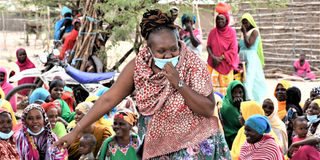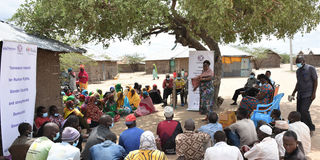Girls’ access to education faced challenges, but Covid-19 made it worse

Terry Mwongeli engaging residents of Tana River County in civic education. Over the past two years, she has rescued more than 400 girls in the county.
Over the past two years, Terry Mwongeli, a lawyer based in Mombasa, has rescued more than 400 girls in Tana River County, emancipating them from the retrogressive arms of culture that deny them access to education.
She has seen it all, but she admits that the Covid-19 pandemic came with even more challenges that she had not seen coming. Just over a month ago, she had to rescue a minor who was defiled by her biological father. How a parent can do that to a child still boggles her mind, she tells Nation.Africa.
For Ms Mwongeli, working as legal counsel at the International Federation of Women Lawyers (Fida) in Mombasa took her to remote villages in Tana River.

Ms Mwongeli says women in Tana River, regardless of age, are marginalised as a result of patriarchy.
She says women in the region, regardless of age, are marginalised as a result of patriarchy. She has interacted with locals from several parts of the semi-arid county, including Majengo, Laini, Chewani, Zubaki, Bondeni, Mikinduni and Village 5, 6, and 10 in Bura.
“There are numerous challenges that girls face in the coast region. Most of them are not given education by their parents, who prefer to educate boys,” she says.
“There is forced and early marriage for the girl child. There are also challenges of reproductive health including menstrual hygiene. Domestic work. Defilement. The list is endless. And Covid-19 made all this worse,” she says.

For Ms Mwongeli, working as legal counsel with FIDA in Mombasa took her to remote villages in Tana River.
Myriad of challenges
While the government has made strides and put measures in place to increase the number of the girls in schools, a myriad of challenges still prevent many, especially in remote parts of Kenya, from accessing classrooms.
Data from the Ministry of Education shows that in 2019, some 2,738,587 children enrolled in pre-primary centres, 10,072,040 in primary schools, and 3,262,951 in secondary schools.
Boys led in numbers in the first two levels of education. There were 1,393,719 boys enrolled at pre-primary level compared with 1,344,868 in 2019.
At the primary level, 5,105,788 boys were enrolled in the same year compared with 4,966,252 girls. However, the trend changes after the primary school level, with more girls enrolled: 1,635,466 girls were admitted to high school compared with 1,627,485 boys.
While the enrolment trend at the high school level is encouraging to campaigners for girls’ rights, the Covid-19 pandemic came knocking last year and eroded a number of gains made over the years.
Schools closed
At first, schools were closed, affecting all learners in the country. Then months later, when schools reopened, school administrators reported that not all learners came back.
A recent joint survey published by the Office of the President and the Population Council, “Promises to Keep”, on the impact of Covid-19 on adolescents in Kenya established that 99 per cent of boys aged 10-14 reported back to school compared with 95 per cent of girls.
The figures worsen in the 15-19 age group, where only 63 per cent of girls re-enrolled in schools compared with 74 per cent of boys.
In Nairobi and Kisumu, it emerged that at least 2 per cent of all adolescent girls were pregnant by February 2021, with an alarming 3 per cent and 11 per cent being recent mothers in the two devolved units, respectively, over the same period.
Child marriage, drop-outs
A 2020 survey by World Vision estimated that about 13,000 girls drop out of school each year in Kenya due to pregnancy.
“While the root causes need to be addressed, the consequence cannot be the removal of one’s right to education,” the charity said.
The Constitution outlaws child marriage under the 2001 Children’s Act. The Marriage Act, 2014, the Prohibition of Female Genital Mutilation Act, 2011 and the Sexual Offences Act, 2006 set the age of marriage at 18 years and protect the girl child from the practices.
The root causes of early teen pregnancies, Ms Mwongeli says, vary and can relate to sexual violence, child marriage, and lack of access to sexual and reproductive health services and to education.
The unavailability of a rescue centre in Tana River County has made her work even more difficult, she says, because locals who need assistance, especially for sexual and gender-based violence, call her for help every now and then.
She laments that the absence of facilities means that she has to pull strings to get temporary shelters for victims.
Transactional sex, rape
Ms Mwongeli believes that poverty is mainly to blame for limiting girls from accessing education. Some of the girls who have reached puberty often fend for themselves and are usually lured to engage in commercial sex to sustain themselves.
An excerpt from “Promises to Keep” showed that at least 4 per cent of teenage girls in Nairobi, 1 per cent in Kilifi, and 5 per cent in Kisumu engaged in transactional sex during the Covid-19 pandemic as of February 2021.
Ms Mwongeli is open with her frustrations at the long court procedures in determining and resolving cases related to sexual and gender-based violence (SGBV).
The long time gives the offenders time to tamper with investigations and at times by threatening their victims and their families to stop their cases and as such, walk away unscathed.
She urges the government to consider setting up an SGBV court to expedite the particular cases.
The zealous lawyer has trained at least 80 elders in Tana River on the importance of taking girls to school and she believes this has transformed the decisions they previously made that were skewed to favour boys, leaving young girls struggling.
Abdulaziz Noor, the Tana River sub-county education director, is a worried man. He reveals how a father was arrested at the tail end of June for defiling his two daughters, 11 and 14, for years.
“The act in itself is criminal and beyond imagination. Our culture does not even allow such practices. I am glad that Chief Habiba Maro and sub-county police Commander Patrick Kafulo worked speedily to arrest the rogue father. The case is now in court,” Mr. Noor says.
Poor attitude
He adds that the poor attitude of locals towards young girls, who are viewed as dowry earners for the family, and early marriages remain a challenge to girls’ education in the area.
“The environment in the coastal region is also not morally upright. There is a lot of drug consumption by men in this community. This makes them seduce little children, who are easily lured by cheap things such as soda,” he says.
But Johnson Nzioka, the chairperson of the Kenya Primary Schools Headteachers Association, feels that the government is not doing enough to ensure all children, both boys and girls, are not only enrolled in school but complete their studies too.

Johnson Nzioka, chairman of the Kenya Primary School Heads Association speaking at a past press briefing.
“Girls have more challenges than boys, especially in Africa, where most societies are patriarchal in nature. But the government is to blame for failing to enforce its rules. Why do we still have bars near schools when we know those drinking dens negatively influence our children?” he wonders.
He wonders what chiefs and sub-chiefs are doing to ensure all children in their areas get an education.
“Rules are there but they are not being implemented. Children are out of school. Girls are sent to be house girls and boys as herds-boys. I blame the law enforcers, the police, and the regional heads for failing to ensure children in their areas are in school,” he says.
Menstrual hygiene
Sylvia Khasoa, founder and CEO of Simama na Dada Initiative, a non-governmental organization that champions the empowerment and education of girls, tells the Nation how lack of menstrual sanitary towels keeps many girls at home. She describes the phenomenon as “period poverty”.
“Without access to toilets or menstrual products at school, many girls are missing out on their education and putting their lives on hold, as they have little choice but to stay at home,” she says.
The study on the effect of Covid-19 on adolescents showed that at least 51 per cent of girls in Nairobi, 54 in Kisumu, 57 in Kilifi and 34 per cent in Wajir had limited access to menstrual hygiene products in the period between June and August 2020.
The numbers remained unchanged by February 2021 for all the counties, with Kilifi reducing the percentage dismally to 56 per cent.
Khasoa is pained by how poverty forces girls as young as 13 to exchange sex for pads, a factor that she says has been embedded in the culture of miseducation.
“One in four girls do not associate menstruation with pregnancy and therefore do not realise the risks of engaging in sexual relations,” she says.
“An educated girl is an instrument to change, not only at her home but the entire community.”





